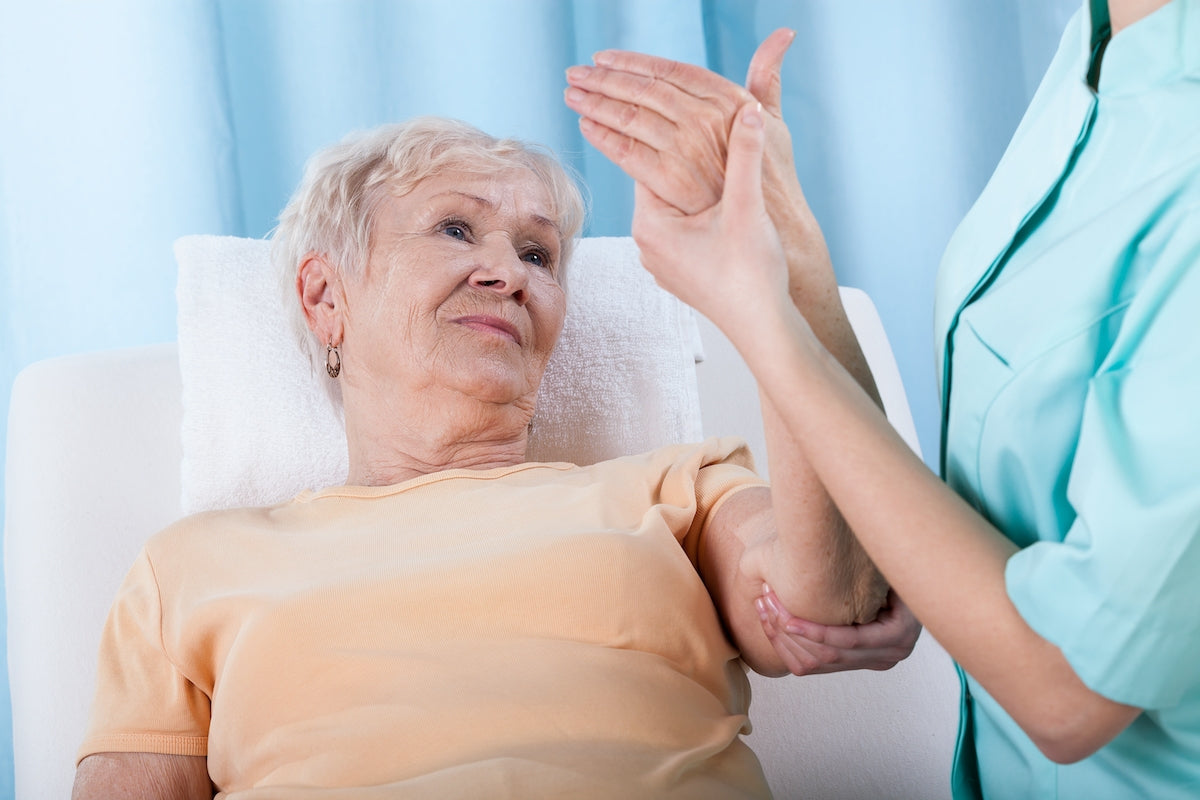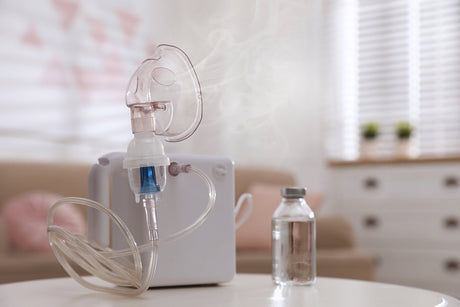Families and loved ones of these patients are often left feeling helpless. This doesn't have to be the case! ApriaHome is passionate about educating Americans about identifying and treating various medical conditions, ensuring you and your loved ones get the most out of every day.
Find out how to treat bedridden and immobile loved ones struggling with bedsores.
What Are Bed Sores: Causes, Prevention & Treatment
Bedsores are skin and tissue injuries caused by continuous pressure. Typically, the skin around the bones (heels, ankles, hips, and tailbone) is most susceptible to developing bedsores.
While anybody is at risk, those who spend extended amounts of time in bed or a wheelchair are more likely to develop bedsores. The wounds can be treated; however, complete recovery is not guaranteed. Untreated, these sores can, in fact, be fatal.
According to research, over 2.5 million individuals in the United States struggle with bed sores.
Those with mobility complications are particularly vulnerable. Bedsores happen when you lie or sit in one position too long and the weight of your body causes pressure at certain points in the body. Families and loved ones of these patients are often left feeling helpless, but this doesn't have to be the case! ApriaHome is passionate about educating Americans about treating and identifying various medical conditions, ensuring you and your loved ones get the most out of every day.
Keep reading to find out how to treat bedridden and immobile loved ones struggling with bedsores.
What Are Bedsores?
Bedsores are open wounds on your skin caused by a long period of constant pressure. Bedsores are the common name for decubitus ulcers, also known as pressure ulcers or pressure sores. A pressure ulcer develops when skin deteriorates after being subjected to prolonged, intense pressure. As a result, reduced blood flow causes tissue damage and tissue death in certain areas.
A bedsore is an injury that breaks down the skin and underlying tissue. The skin overlying bones is a common site for decubitus ulcers to develop. Seniors and those with limited mobility seem more susceptible to this condition. Infections pose a severe health risk when they spread to vital organs and tissues such as the blood, heart, and bones.
The great news is that bedsores can be treated. An individual's prognosis depends on many variables, such as the severity of the ulcer and any underlying medical issues.
What Are The Symptoms Of Bedsores
There are multiple stages for bed sores to advance to. These four stages help healthcare providers better diagnose and treat the condition. A decubitus ulcer in stages 1 and 2 typically doesn't need surgery, but those in stages 3 and 4 sometimes do.
Each stage of a bed sore is characterized by varied symptoms. Depending on the stage, any of the following may be present in an area of injured skin:
- Skin discoloration
- Ache, itching, or discomfort in the afflicted region
- Skin that does not lighten upon contact
- Softer or firmer skin than the surrounding surface area
- Open/broken skin
- Necrosis, or black-looking dead tissue
Symptoms of infection include:
- An unpleasant odor
- Discoloration or inflammation surrounding the area
- Pus or discharge of a greenish color
- Persistent fever
Stage 1:
Characterized by unbroken but discolored skin. Those with fair skin may notice a reddened appearance in the area. For those with darker skin tones, the discoloration may range from blue to purple.Bed sores at this stage will:
- Feel painful and warm when touched
- Appear swollen, present an itching or burning sensation
Stage 2:
This affects the top layers of skin, the epidermis, and the dermis. At stage 2, a skin break exposes a superficial sore or cut that sometimes creates a discharge. The wound also may resemble a fluid-filled blister. The ulcer will be painful, and the skin around it may be discolored.
Stage 3:
At stage 3, the ulcer forms deeper beneath the epidermis, damaging the skin's fat layer. The sore may have a crater-like appearance and an unpleasant odor.
Stage 4:
At this stage, a pressure ulcer has become very deep and affects many different layers of tissue and sometimes the bone. You will be able to observe muscle, bones, tendons, joints, and a lot of dead tissue and discharge.
Uncategorized:
Occasionally, it is impossible to determine the depth of a wound or the extent of tissue damage, which complicates the evaluation and staging of an ulcer. This might result from a hard plaque known as an eschar inside the sore. The wound may appear tan, black or brown in color. Bedsores may also include matter referred to as slough, often yellow, brown, green or tan in color.
What Causes Bed Sores?
Bedsores develop when continuous pressure restricts blood flow to the skin. Limited mobility can often lead to skin damage and the development of bedsores. Bedsores are caused by three major factors:
- Pressure:Reduced blood flow to tissues is one of the consequences of long-term pressure on any region of the body. Transportation of oxygen and other nutrients to cells and tissues relies on a steady blood supply. Skin and surrounding tissues might get damaged or even die without these nutrients. The tailbone, shoulder blades, spine, hips, heels, and elbows are particularly susceptible to this sort of strain as they are positioned over the bone and inadequately cushioned with muscle or fat.
- Friction: When a person's skin brushes against their mattress or clothes, this is known as friction. If the skin is already delicate and moist, this increases the risk of damage.
- Shear: When two surfaces move in opposing directions, a shear force is generated. For example, when a person slides down into a bed or chair, the pressure causes the skin to constrict, cutting off blood flow to the area.
Risk Factors For Developing Bedsores
Those experiencing limited mobility and being unable to shift positions when sitting or in bed are at a higher risk of developing pressure ulcers. Other risk factors for pressure ulcers include:
- Inadequate Nourishment And Hydration: People need sufficient water, nutrients, vitamins, and minerals in their regular meals to maintain good skin and avoid tissue breakdown.
- Sensory Loss: Caused by a number of medical issues, including spinal cord injuries, neurological illnesses, and other conditions. Without the capacity to register pain, a person may not recognize the body's signals, alerting that they need to shift their posture.
- Incontinence: Skin becomes more susceptible after prolonged contact with urine and excrement.
- Poor Circulation: Circulatory disorders are a class of medical illnesses that cause problems with blood flow. Tissue damage, including bedsores, is more likely when blood flow is impeded by conditions like diabetes and vascular disease.
Preventing Pressure Ulcers / Bedsores
Bedsores are far easier to prevent than to treat. A patient's risk of developing pressure sores should be evaluated by a member of the care team, and a strategy to prevent pressure sores should be implemented.
When a patient is bed or chair-bound, lying down or sitting, different parts of the skin are more likely to get damaged. Bedsores can be prevented by the following:
Easing Localized Pressure
- Frequently shift the body's positioning (+- every 2 hours)
- If possible, frequently standing will help relieve pressure and restore circulation
- Make use of mattresses and cushions designed to relieve pressure
- Avoid dragging heels or elbows when shifting position
Maintaining Healthy Skin Condition
- Maintain a hygienic & hydrated skin condition
- Avoid letting moisture build up between the skin and bed/ chair surfaces
- Use gentle, fragrance-free soaps
- After cleansing, you should apply a rich moisturizer
- Avoid talcum powder as it removes skin's natural oils
General Prevention Guidelines
- Before patients get into bed, check to see that the sheets are smooth and free of wrinkles
- Cotton or a silk-like fabric are ideal for bedridden patients
- Ensure a healthy and well-balanced diet
- Drink no less than 2 liters of fluid daily
- Immediately report any changes to the skin's appearance or discomfort to a health care professional
Treating Pressure Ulcers / Bedsores
Relieving the pressure that's causing the ulcer, dressing the area, managing the discomfort, avoiding infection, and maintaining a healthy diet are all important parts of treating pressure ulcers.
- Bandages: A bandage's ability to keep a wound hydrated while applying slight pressure aids in its recovery. In addition to acting as a moisture barrier, it also helps prevent infection. A combination of films, gauzes, gels, foams, and treated bandages are all ideal options for dressings.
- Wound Cleaning: Injuries can't heal correctly if they contain any diseased, dead, or otherwise compromised tissue. Debriding refers to the process of removing diseased or injured tissue, which may be done by cleaning the wound with high-pressure water jets or surgical removal.
- Surgical Procedure: The surgical treatments may involve debriding, cleaning, and sealing the wound. In severe cases, the surgeon may harvest healthy skin to use for the repair.
- Dietary Alterations: While there is limited data that suggests a particular diet will aid in the treatment of pressure sores, adding in more protein may speed up the healing process. Maintaining good health requires a balanced diet rich in key nutrients and lots of water.
- Medication: Topical or nonsteroidal anti-inflammatory medicines containing ibuprofen can be used to alleviate pain. These may be quite effective before and after repositioning and wound care.
- Treating Incontinence: Treat incontinence using body waste management systems, cleansers, barrier treatments, and incontinence pads.
Bedsores FAQ
What cream is best for bedsores?
The best options for treating pressure sores are those that are hydrocolloid, antimicrobial, or contain alginic acid. Topical creams contain anti-bacterial properties, while barrier creams can protect against skin damage.
What does a bedsore look like?
The bedsore begins as a red, painful patch that gradually becomes purple as the skin dies. If the skin is not treated, it can break open and become infected.
Can you die from bedsores?
Bedsores can quickly progress into life-threatening infections if they are not properly diagnosed and treated. As reported by the CDC, one in ten nursing home residents develop bedsores or pressure sores each year. A further study revealed that over 60,000 individuals die every year as a direct result of bedsore-related complications.
Treating & Preventing Pressure Sores, Maintaining Optimal Health & Well-Being With ApriaHome
The good news is that a wide range of ulcer management products exists. With proper identification and treatment, severe bedsore complications can be treated.
ApriaHome sources and supplies a comprehensive range of medical equipment, supplies, and treatment solutions, all from the convenience of one online portal.
We understand the challenges bed or chair-ridden patients face and believe that with proper awareness and education, prevention and treatment can be a breeze.
We've selected the best treatment for bed sores and ulcer management solutions from around the world, available to you from the comfort of your own home.
The ApriaHome Home Care Kit For Pressure Wound Care:
For all the supplies you’ll need for your home care kit, view our Wound Care items and stock up on the essentials.
Looking for something specific? Our helpful agents are on call at (800) 780-1508 between 8:00am - 10:00pm EST daily. Get in touch today.




